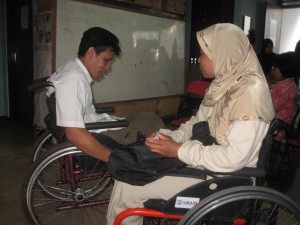Assessment on Private Sector Employment of People With Dissability
Consultant: Ima Susilowati & Indana Laazulva
CIRCLE Indonesia, supported by Social Protection Programme, GIZ
Executive Summary
The research aims to (1) provide case studies of private companies that employ a significant number of persons with disabilities (PWDs) of above 1% of the total employees as required by the Law; (2) identify private companies to support better employment for persons with disabilities; (3) identify key human resource demands of private companies to increase formal labour absorption among person with disabilities; (4) identify key factors that inhibit and/or encourage companies to employ PWDs, (5) to draw lessons from the study that will inform the development of recommendations on vocational & academic training.
The research was conducted in 8 companies (2 in Yogyakarta, 1 in Sidoarjo, 1 in Surabaya, 3 in Jakarta, and 1 in Bogor) that employ a significant number of persons with disabilities (PWDs) (close to or above 1% of the total employees), as follows: CV Sogan Jaya Abadi (Yogyakarta), PT Adi Satria Abadi (Yogyakarta), PT Indosiar Visual Mandiri (Jakarta), PT Magenta Mediatama (Jakarta), PT Omega Plastik (Sidoarjo), PT Rajawali Mulia Perkasa (Bogor), PT Wangta Agung (Surabaya), and Shangri-La Hotel (Jakarta). The number of persons with different disabilities employed in the eight companies ranges between 1.3% to 37%. Data collection was carried out between 18-26 June 2014 through in-depth interview method.
Requirements for the qualifications of labour differ greatly among companies, depending on the job titles and characters. Non-operational jobs in companies require sufficient academic educational qualifications while jobs with more operational responsibilities demand more vocational education. There is a high level of employment of persons with disabilities to fill operational positions in companies but the level is very low for managerial positions. In addition to requirement for technical qualifications, companies nowadays put more priority to good attitude (including high work motivation, high self-esteem, ability to take initiative, good faith to help others) and good communication skills rather than work experience and educational background.
A number of practical as well as strategic factors have encouraged the employment of persons with disabilities in private companies. Practical factors are the ones which have nothing to do with the structure (social, cultural, etc), while strategic factors are the ones that are related to the structure. Almost all companies participating in the research indicate that they recruit persons with disabilities for practical reasons. Limited number of workers and the intention for a “trial and error” in using PWDs were among the reasons for hiring PWDs. Most of the companies covered in the research have indicated that they never intentionally planned to hire PWDs in the first place.However, over time companies see that employees with disabilities can perform as well as those without disabilities. In many cases PWDs have shown much better productivity than the employees without disabilities.. They are not aware of the regulations governing the importance of employing PWDs.. The fact that PWD can perform well has encouraged companies to keep hiring PWDs and increasing the number of employees with disabilities for certain jobs that relate with their types of disabilities.
One international company in this study recruits PWD for strategic reason. The company believes that PWD has equal rights to job opportunities to make them free from marginalization. In addition, the company indicate that employing PWD is part of their corporate responsibility and concern to persons with disabilities. It has the systematic policy and systems in place for the employment of PWD that are not found in other companies covered in this research that do not work at the international level.
A number of challenges are facing companies in employing persons with disabilities. First, some of the companies have indicated that they do not have sufficient information on how to recruit persons with disabilities and where they can source labour with disabilities, especially those who have the skills required by the companies. This is possible due to lack of connectivity among companies, the government, and agencies that provide the labour force with disabilities for companies.
Second, internally, there is a misconception among divisions of the companies that hiring persons with disabilities means creating a burden to the companies due to PWDs’ lack of mobility. To address this, companies are required to reduce the misconception through harmonisation among divisions.
Provision of facilities and equipment in the workplace for PWD is also another challenge. Not all companies can afford to provide special facilities for the employees with disabilities (for instance special toilet, ramp). In some cases, companies have to withdraw from recruiting people with specific disabilities such as those with wheelchairs due to unavailability of special facilities that can provide accessibility to these people in the workplace. In the meantime, employees with hearing and speech impairment pose another challenge to the companies when it concerns communication among employees and provision of work instruction. It took a long time for the companies to find the appropriate and suitable pattern of communication that can be accessible by employees with these types of impairment.
This study will emphasize to provide recommendations for provision of vocational and academic training programmes towards an enhanced participation of persons with disabilities in the labour market. In the short term, it is recommended to increase and extend the outreach of special vocational training institutions for PWDs to enable them to be absorbed by the labour market. The limited number and distribution of vocational training institutions have led to the very limited number of persons with disabilities who are ready for the labour force. It is also necessary to increase the number of job fairs that can bridge the communication among PWDs, disabled people community, vocational training institutions, and user companies.
It is also important to note that some companies in the research complained of the unsuitability of the curriculum provided by vocational training programs with the companies’ need. Therefore, companies need to be involved in preparing the skills and work equipment that PWDs have to master to meet the companies’ need. Furthermore, to improve PWDs’ psychological readiness in the job market and to boost their motivation, more trainings are necessary to prepare them to meet the demand of the workforce for speed, accuracy, quality of production and competitiveness.
In the longer term, the government has to make available inclusive formal education at all levelsto be accessible to students with disabilities. The more PWDs with relatively higher level of formal education, the more ready they are to fill higher positions in companies. Persons with disabilities are often constrained to climb the ladder of managerial position due to lack of necessary qualified education.
Recent Posts
- In Your Hands: One Earth for All
- CIRCLE Climate Discussion #2: City Adaptation Efforts in the Global Era Boiling – Delves into Climate Phenomena and Climate Adaptation Methods in the Urban Sphere.
- ”Hybridity”, From Photobook to Documentary Film: A Presentation of Visual Works that Explore Environmental Issues through Various Landscapes of Sense
- CIRCLE Climate Discussion #1: Mapping and Enriching Our Climate Dictionary for Productive Climate Discourse
- Regional Community Consolidation in Yogyakarta in Welcoming the Global Power Up Action: Transition to Solutions
Recent Comments
Archives
- January 2024
- December 2023
- November 2023
- October 2023
- August 2023
- June 2023
- May 2023
- March 2023
- October 2022
- September 2022
- March 2022
- February 2022
- July 2021
- December 2020
- July 2020
- June 2020
- May 2020
- December 2019
- November 2019
- August 2019
- July 2019
- May 2019
- April 2019
- January 2019
- September 2018
- August 2018
- July 2018
- January 2018
- November 2017
- October 2017
- September 2017
- August 2017
- July 2017
- June 2017
- May 2017
- April 2017
- March 2017
- December 2016
- November 2016
- October 2016
- July 2016
- June 2016
- April 2016
- January 2016
- December 2015
- September 2015
- July 2015
- May 2015
- January 2015
- December 2014
- August 2014
- April 2014
- March 2014
- February 2014
- January 2014
- December 2013
- November 2013
- October 2013
- September 2013


